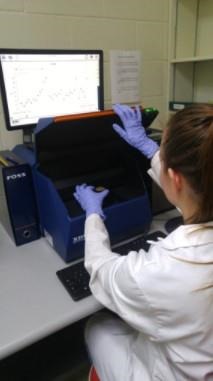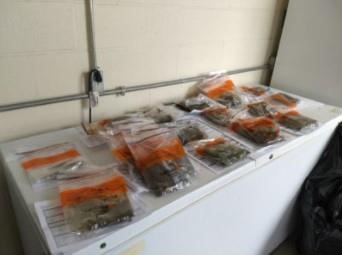While most people shy away from a cow patty, the mounds of manure contain a plethora of valuable information for cattle ranchers. Testing manure and deciphering the results of the tests is the job of the Texas A&M AgriLife Grazingland Animal Nutrition Lab, GAN Lab.
The GAN Lab provides manure testing services to aid ranchers in making nutrition-related decisions for their herd. It is overseen by Raghavan “Srini” Srinivasan, Ph.D., center director at Texas A&M AgriLife Research and Extension Center in Temple.
Testing history
The lab has been providing manure testing services using near infrared reflectance spectroscopy, NIRS, on cattle, goats, white-tailed deer and bison since 1994. This technology uses electromagnetic vibrations to probe bulk material and is used in the medical and pharmaceutical industries, as well as in food quality control.
The NIRS results are integrated into NUTBAL Online, an modeling software that calculates the nutritional balance or quality of an animal’s diet, including projected daily weight gain or loss.
Initially, Texas A&M AgriLife Research scientists would travel to nearby ranches to collect manure samples. Today, ranchers all over the country conduct the sampling themselves, shipping the material to be analyzed to the lab in special insulated coolers. The lab then sends ranchers the results in about a week.
Simple cost savings
Manure collection is a fairly uncomplicated and low-tech process for the rancher. The lab provides the necessary spoon, baggie and cooler in a kit.

Lab technician using Near Infrared Reflectance Spectroscopy to test a manure sample.
“For $45 and a trip to the post office, ranchers can determine diet quality for their herd, save time and money, potentially earn higher profits, and gain valuable information to help improve their land management strategies,” Srinivasan said.
“The cost of the manure testing is minor when you consider the feed savings,” said Frank Perry, a rancher in Pauls Valley, Oklahoma, who has raised registered Brangus cattle since 1997. “You can fine-tune your feeding program, and if you save $20 to $30 per cow, it adds up pretty fast for a herd of 200-300 cattle,” Perry added.
Perry has been using the lab’s testing services for the last five years to adjust how he feeds his cattle. He also recommends the lab’s services to people who are new to cattle ranching.
“It is a great way to test what you are seeing and make sure you are seeing what you think you are,” said Perry, a member of the Conservation Stewardship Program, CSP, run by the U.S. Department of Agriculture’s Natural Resources Conservation Service. “You can adjust the feed in small amounts and make changes based on performance and the time of year.”
While membership in the CSP is not required to use the lab’s services, the testing services do meet a requirement for the program. Members who commit to the five-year program receive financial incentives as well as valuable technical assistance, such as recommendations for cover crops for rotational grazing and wildlife-friendly fencing. The program helps livestock producers conserve wildlife, protect grazing land and improve soil health and water quality.
Testing during the busy season

Manure samples arrive at the Grazing Animal Nutrition Lab in Temple.
“Manure testing season is busiest from May to early June,” said Kimberly Sanchez, business analyst at the lab. “This year, the lab has set a goal of processing 19,000 manure samples, up from 12,000 during 2020 when COVID affected the ability for many to sample the way they normally did in other years.”
“Manure analysis occurs year-round, and we want everyone to know we are open for business and working hard,” Srinivasan said. “COVID knocked us all back some last year, but we at the lab are here and ready to process samples. Samples are coming in and our clients are eager to get back to their normal practices after the pandemic and the freezing temperatures they experienced a couple of months ago.”
“Data shows it is not just individual ranchers using the lab’s testing services,” said Tony Owen, GAN Lab senior research scientist. “The lab also processes over 1,000 research samples each year for various in- and out-of-state universities, state wildlife agencies and private businesses. In the past, we have processed samples for a national park and several Indian reservations and pueblos.”
New electronic tools, resources for customers
Over time, lab staff has recognized the need for additional tools and educational resources for customers.
“Our customers are technologically savvy and many want to be able to use their smartphones, tablets or laptops to help with their ranching practices,” Srinivasan said.
To meet this need, the lab created ways to electronically walk customers through the manure testing process, providing step-by-step online tutorials covering topics such as manure collection and how to read the lab reports. The lab also has recently begun accepting credit card payments.
Source : tamu.edu